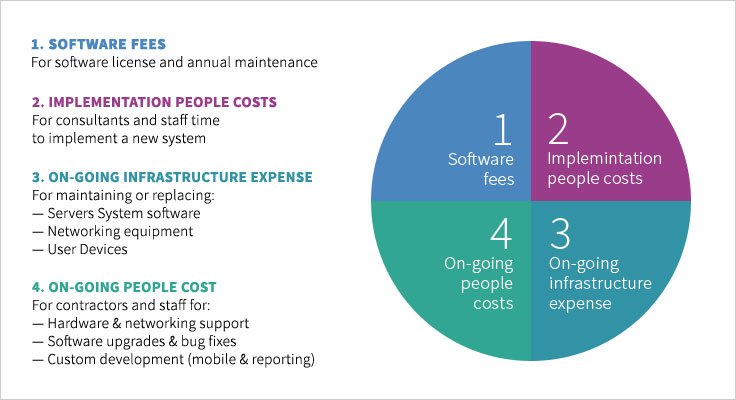
How much does an ERP system cost?
You may currently have a legacy ERP system, such as Sage, Microsoft Dynamics, Infor, JD Edwards, Made2Manage, or
one of the many others. It may not be serving you well today. You always have the opportunity to make a choice:
- Maintain the current system and postpone getting the benefit of a modern system
- Make the decision to move to a modern system
Of course, when purchasing a new ERP system, one of the first questions everyone asks is: How much will it cost?
Many factors are involved, from purchasing and installing equipment to configuring the software to ongoing maintenance.
True Cost = ROI – TCO
Most pricing models just calculate the initial hardware infrastructure, software licensing expenses, and implementation
costs, but do not consider the impact of ongoing operating expenses.
Return on Investment (ROI)
In our pricing model, we first look at the potential cost savings or Return on investment (ROI) the system will offer you. Some
results can be hard to measure, such as improvements in employee satisfaction and teamwork. As part of our
due diligence our local partners can help you determine your possible ROI.
Total Cost of Ownership (TCO)
The software license fee is not the cost of the software. The total cost of owning and maintaining the system over the 7
to 10 years expected life includes a great deal of “hidden” on-going people costs, plus your annual maintenance
fee. That fee is typically about 18% of the current list price of the software every year. This means you
are repurchasing your system every 5.5 years.
This annual maintenance fee gives you the unique opportunity every year to:
- Maintain your current legacy ERP system and receive no additional business benefits. We call this “The Cost
of Doing Nothing”. - Replace your current system with a modern ERP system and start realizing the additional benefits of increased
ROI.
Calculate the Total Cost of Doing Nothing versus Investing in a Modern System
Acumatica has developed a simple tool to help in developing the cost of both decisions. We start by asking you
5 simple questions.
I am considering keeping my legacy ERP system
What are my ongoing costs?
Summary of the cost of doing nothing
This graph shows how the costs compare:
- In most cases the subscription price is more than purchasing the perpetual license outright
- However, the annual software and on-going IT support is significantly higher
Cost of doing nothing (Graph 1)
Breakdown of cost over 5 years (Table 2)
| Cost to maintain legacy on-premises system | Cost to move to a modern SaaS system |
|---|
Important – This is an example snapshot of the cost comparisons. Contact our team to get a personal
evaluation of the costs that are unique to you.
Still have questions? Then take your time and learn more about cloud ERP, research ERP solutions, or evaluate the ERP systems you’re considering.